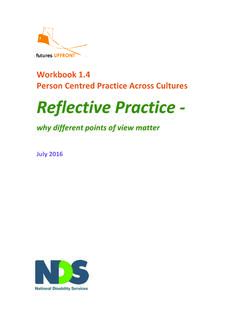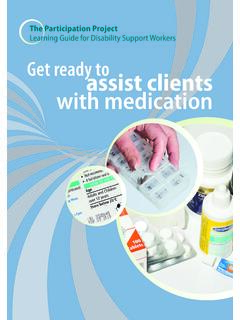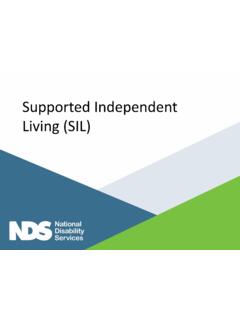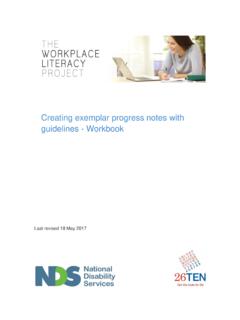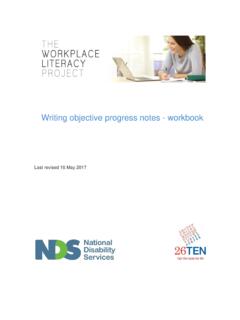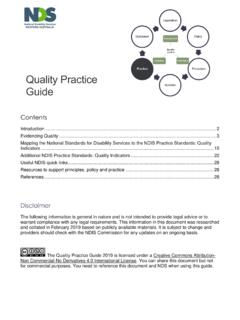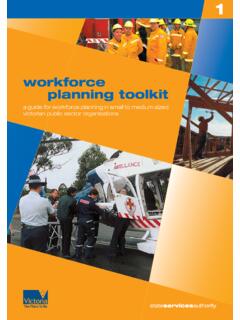Transcription of THE NDIS PROVIDER TOOLKIT - National Disability Services
1 THE NDIS PROVIDER TOOLKITA self-assessment of organisational capability to operate under the National Disability Insurance Disability Services LimitedABN 52 008 445 485 National OfficeLocked Bag 3002 DEAKIN WEST ACT 2600 Email TOOLKIT is available online 3 April 2015 The Sector Development Fund (SDF) was established by the Australian Government and is administered by the National Disability Insurance Agency to assist the disabilityservices sector (including people with Disability , their families and carers) to transition to the new NDIS 2 The TOOLKIT 4 The Key Financial Ratio Tool 5 The Self-Assessment Tool 7 Strategy 8 corporate governance 11 Clients and market focus 20 Financial sustainability 24 People and capability 31 Information and knowledge management 38 Safeguarding, quality management and improvement 40 Key Financial Ratios 43 Concerned about your organisation s results?
2 47 Acting on your results 49 Summarising your results 50 Development Plan 54 Monitoring your progress 55 Glossary 562 INTRODUCTIONThe Australian Disability sector is experiencing the most significant reforms in its history. Gradual state and territory shifts towards individualised funding and support models for people with Disability have been accelerated by the introduction of the National Disability Insurance Scheme (NDIS) and actions documented in the National Disability Strategy 2010-2020. The NDIS will give people with a Disability greater control and choice over the Services they receive. It will also fundamentally change the way Disability care and support is provided in Australia, leading to substantial growth, restructuring and transformation. To facilitate the formation of a well-designed scheme, the NDIS is being rolled out in stages.
3 Full scheme roll out is scheduled from July 2016. National Disability Services (NDS) is helping Disability service providers develop the organisational capability to operate in an NDIS environment. The PROVIDER TOOLKIT (the TOOLKIT ) has been developed to support organisations intending to become a registered service PROVIDER of the TOOLKIT puts the various implications of the NDIS reform into a business excellence framework. This framework is structured around seven business domains that we encourage you to use in your approach to positioning your organisation for the might find the domains useful in board or staff meetings, and especially as an introduction to completing the self-assessment TOOLKIT The first version of the TOOLKIT was launched during 2013 to assist providers entering the first NDIS trial sites. The current version has been updated to ensure it remains responsive to business practices that have been identified as being important since the introduction of the TOOLKIT is geared to organisations whose primary business is Disability (including psychosocial Disability ), but is also applicable to multi-service providers.
4 It has been developed with the needs of small to medium sized providers in mind, but many of the practices are universal and relevant to organisations of all TOOLKIT assumes that organisations have a moderate level of knowledge of management practices. A glossary is provided, however, jargon has been avoided as much as does our strategy allow us to be agile, flexible and responsive to the changes in our sector? corporate governanceDo our decision-making processes allow us to effectively manage the key risks, challenges and opportunities facing our business? Clients and market focusHow will we differentiate ourselves to retain and attract clients in an increasingly competitive market?Financial sustainabilityWhat impact will individualised funding have on our business and the way our Services are costed, priced and funded? What changes do we need to make?
5 People and capabilityHow will we attract, recruit and retain staff with the right values, skills and capabilities to support the changing needs of our clients and our business?Information and knowledge managementDo we have the right information systems in place to respond to the reforms? How will our systems support the necessary changes to our business, clients, operations and finances over the next decade?Safeguarding, quality management and improvementHow do our systems, processes and people help us to maintain and improve our safety, quality and performance? How will we know when we are doing well, or at risk?4 THE TOOLKITWHAT IS IN THE TOOLKIT The time you need to complete the two components of the TOOLKIT will vary depending on your organisation s size and any prior planning already COMPONENTWHAT IS IT?HOW LONG WILL IT TAKE TO COMPLETE?The Self-Assessment ToolA core component of the TOOLKIT , this allows you to assess and rate your organisation s current state of transition toward the NDIS and plan for where it needs to self-assessment will take one person between one and four hours to complete, depending on the complexity of your service and your existing level of preparedness.
6 If the Tool is completed as a group (preferable), allocate between three and six Key Financial Ratios ToolThese ratios will give you an insight into your organisation s current Disability revenue concentration, liquidity, debt and these ratios should take one person no more than thirty minutes. Depending on your results, group discussion of the implications of your results could take an hour or DO I ACCESS THE TOOLKIT ?The TOOLKIT can be accessed at WHy IS THE TOOLKIT ONLINE?Completing the TOOLKIT online will allow you to automatically generate: A gap analysis that measures the distance between your current practice and the state of practice you think your organisation will need to operate under the NDIS; A benchmark report that allows providers to periodically compare their state of NDIS transition to the average result for all others that respond, and filter by state, turnover, region, service type and client type; Key financial ratios with accompanying commentary on how to interpret them.
7 And A development plan that captures the organisational priorities you have identified for action, timelines and who is KEY FINANCIAL RATIO TOOLHOW IT WOrKSFinancial ratios are commonly used by organisations to assess performance and identify where the business is figures closely allows the organisation to maximise efficiency and minimise waste, which will help during transition to the risk for organisations is increased under the NDIS because most organisations will move from block funding paid in advance to individual payments made in arrears. In this context it is critical to monitor and manage activity levels and cash flow. Further, where block payments end, your organisation will no longer earn interest from investing payments made in TOOLKIT uses high level ratios that can be calculated from the annual reports of most organisations.
8 The table on the next page describes the ratios and what they THIS rATIO EXPLAINSR evenue concentrationThis ratio identifies the percentage of your income which comes from Disability service provision. The higher the percentage, the greater the potential impact the NDIS could have on your organisation. A diversity of major revenue sources is sometimes considered to be more desirable. However, this depends on your organisational ratio: month of spendingThis ratio establishes the number of months of cash available to cover expenditure. This may indicate whether your organisation can make the transition from payments in advance to payments in arrears. As a rule of thumb, 3 months or more of spending is ratio: current This ratio measures your organisation s ability to meet its financial commitments in the next 12 months. A ratio of less than is concerning, while a ratio of less than 1 indicates that your organisation should seek accounting and legal advice as it is possibly trading while insolvent.
9 A very high current ratio might indicate opportunities for the more effective use of cash funds. This is because you might have more money in operating accounts than you ratio: debt to total assetsThis ratio measures the extent to which assets are funded by debt. The preferred result is low, towards Higher ratios may indicate an organisation s inability to service its ratio: surplus margin (profit margin)This ratio explains the rate at which your organisation currently builds reserves from revenue. These reserves can be used for working capital, for future service delivery, for investment in the organisation s infrastructure or for investment in revenue-generating activities. The preferred result for both periods is a positive figure. An organisation which regularly has negative returns will not be viable in the longer term. Boards and management teams might establish a target level of surplus (profit) ratio: return on assetsThis ratio is an indicator of the organisation s effectiveness in managing its assets to generate a surplus (or profit).
10 It is an indicator of efficiency. The preferred result is higher than the annual rate of SELF-ASSESSMENT TOOLHOW TO USE THE rATING SCALEThe self-assessment tool is based on the principle of organisational maturity, which is the degree to which business practices in your organisation are fully optimised. You can rate your organisation s state of maturity on a scale of 1 to 5. This involves thinking across practices at two levels: essential and advanced .To calculate your rating for each issue, read the essential practices for being effective under the NDIS: If your organisation has none of the essential practices in place, rate your organisation at 1. If you have some of the essential practices, rate your organisation at 2. If you have all the essential practices, your organisation is rated at least 3. Once you have all the essential practices in place, you can check if you have any of the advanced practices.

